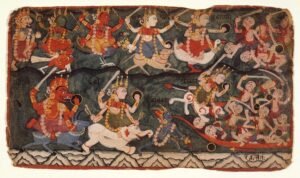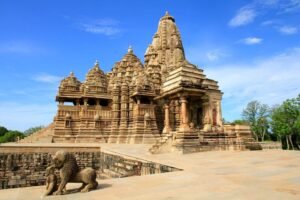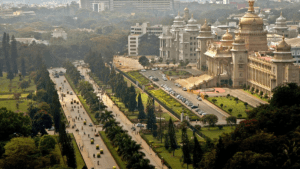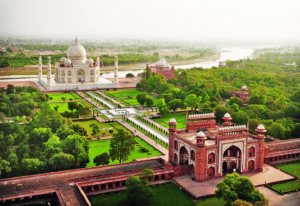Varanasi: The Eternal City of India | Incredible India 2023
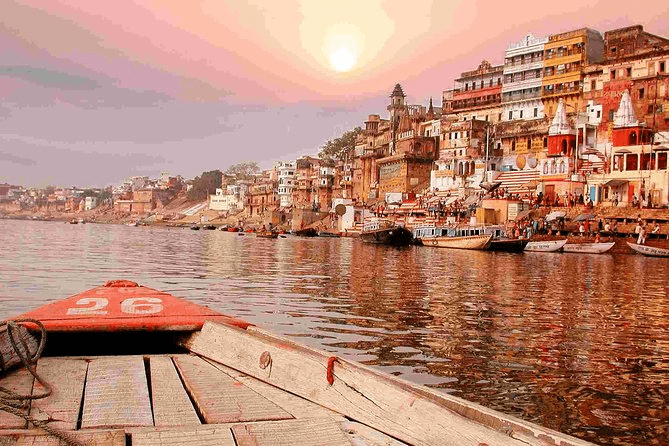
Kashi or Benares
Varanasi, also known as Kashi or Benares, stands as one of the world’s oldest continually inhabited cities, a testament to the enduring essence of Indian civilization. Nestled on the banks of the sacred Ganges River in the northern Indian state of Uttar Pradesh, this ancient city has witnessed the ebb and flow of empires, the rise and fall of religions, and the passage of countless souls seeking spiritual solace. With a history spanning over three millennia, Varanasi is a living chronicle of India’s cultural, religious, and philosophical heritage.
Ancient Origins
The history of Kashi is shrouded in myth and legend, making it a place where history and mythology seamlessly intertwine. According to Hindu mythology, Lord Shiva, one of the principal deities of the Hindu pantheon, founded Varanasi or Kashi as it is known in ancient texts. Thus, the city is often called “Shiva ki Nagari” or the “City of Shiva.” Its history can be traced back to the Vedic period, which dates to around 1500 BCE.
Early Settlements and Growth
The earliest settlements in the region that would become Kashi were likely established by the Indo-Aryans. These early inhabitants were engaged in agriculture and cattle rearing. Over time, Varanasi grew as a center of trade and commerce due to its strategic location on the Ganges River.
During the sixth century BCE, the region came under the influence of the great spiritual teacher, Gautama Buddha. The nearby city of Sarnath witnessed the Buddha’s first sermon, marking the beginnings of Buddhism. This period also saw the spread of Jainism, another significant religious tradition.
The Mauryan and Gupta Empires
Varanasi’s historical importance continued to grow under the Mauryan Empire, particularly during the reign of Emperor Ashoka (c. 268–232 BCE). Ashoka’s patronage of Buddhism led to the construction of stupas and monasteries in Sarnath and Varanasi.
During the Gupta dynasty (c. 4th to 6th centuries CE), Kashi became a major center for learning, philosophy, and the arts. Scholars like Panini, the grammarian, and Patanjali, the compiler of the Yoga Sutras, contributed to the city’s intellectual vibrancy.
Medieval Period: Turmoil and Cultural Flourishing
The medieval period brought a series of invasions and dynastic changes to the Indian subcontinent. Varanasi, too, experienced its share of turmoil. It was conquered by various rulers, including the Guptas, the Hunas, and the Maukharis, before being annexed by the Rashtrakutas and later the Cholas.
Despite the political upheaval, Varanasi remained a hub of culture and spirituality. The city’s religious significance only grew during this period, attracting scholars, poets, and philosophers. The rise of various sects within Hinduism, such as the Bhakti and Tantric movements, contributed to Kashi’s spiritual diversity.
Islamic Rule and Cultural Syncretism
The arrival of Islamic rulers in India, beginning with Mahmud of Ghazni in the 11th century, marked a significant turning point in the history of Varanasi. The city came under Muslim rule and saw the construction of several mosques and Islamic structures, including the Gyanvapi Mosque. However, despite the changes in political power, Varanasi’s syncretic culture continued to flourish.
One of the most famous instances of religious syncretism in Varanasi is the Ganga Aarti, a daily ritual performed on the ghats (steps leading to the riverbanks). This ceremony, which blends Hindu and Islamic elements, is a testament to the city’s harmonious coexistence of diverse faiths.
Mughal Period and Aurangzeb’s Reign
During the Mughal period, Varanasi experienced both patronage and challenges. Akbar, one of the most notable Mughal emperors, was known for his religious tolerance and encouraged a culture of interfaith dialogue. His reign saw the construction of several magnificent temples in Varanasi.
However, the 17th century brought significant tension with the reign of Aurangzeb, who sought to impose stricter Islamic orthodoxy and banned various Hindu practices. The city endured a period of decline and destruction during his rule.
Maratha and British Rule
The 18th century witnessed the rise of the Marathas in North India, and Varanasi came under their control. The Marathas provided stability and patronage for the city, allowing it to recover from the effects of Aurangzeb’s rule.
The British East India Company’s rule in the 19th century brought Varanasi into the orbit of the British Empire. This period saw significant changes in the city’s administration, infrastructure, and economy. The British also made efforts to document and study India’s rich cultural heritage, leading to a revival of interest in Varanasi’s ancient texts and traditions.
The Struggle for Independence
Varanasi played a significant role in the Indian independence movement. Leaders like Pandit Madan Mohan Malaviya, who founded the Banaras Hindu University (BHU) in 1916, and Dr. Annie Besant, who delivered speeches advocating for freedom from British colonial rule, made Varanasi a center of political and intellectual activity.
The city witnessed several key events during the struggle for independence, including protests, strikes, and movements that culminated in India gaining its freedom in 1947.
Modern Varanasi: A Spiritual Center
Today, Varanasi stands as a testament to India’s enduring spirituality and cultural richness. It continues to be a pilgrimage destination for millions of Hindus who come to bathe in the sacred waters of the Ganges River, seeking spiritual purification and liberation from the cycle of reincarnation.
The city’s numerous ghats, including the Dashashwamedh Ghat and Manikarnika Ghat, serve as focal points for rituals, ceremonies, and cremations. The Varanasi ghats are not just places of religious significance but also hubs of social and cultural activity, where people come to interact, meditate, and observe the ebb and flow of life along the riverbanks.
Cultural Heritage
Varanasi’s cultural heritage is a tapestry woven with threads of music, art, dance, and literature. The city has been a crucible for classical Indian music, giving rise to the Benaras Gharana, a prominent school of classical music. Distinguished musicians and artists, such as Pandit Ravi Shankar and Ustad Bismillah Khan, have their roots in Varanasi.
The city’s vibrant silk industry has produced exquisite Banarasi silk sarees, known for their intricate designs and craftsmanship. Varanasi is also known for its traditional handicrafts, including metalwork, woodwork, and intricate handwoven textiles.
Religious Diversity and Harmony
Varanasi’s religious landscape is characterized by diversity and coexistence. Besides Hinduism, the city is home to numerous other faiths, including Buddhism, Jainism, Islam, and Christianity. Sarnath, just a short distance from Varanasi, remains an important pilgrimage site for Buddhists, as it is where Gautama Buddha delivered his first sermon after attaining enlightenment.
Buddha in Varanasi: A Journey through Spiritual Significance
Varanasi, the ancient city that has witnessed the passage of millennia, stands as a testament to India’s rich cultural and spiritual heritage. While renowned as a sacred hub of Hinduism, Varanasi also plays a pivotal role in the history of Buddhism, particularly in the formative years of this profound spiritual tradition. In this article, we embark on a journey through the city’s spiritual landscape, exploring the significant presence of Buddha in Varanasi.

Sarnath: The Cradle of Buddhist Teachings
Sarnath, a serene and historically significant suburb of Varanasi, is often referred to as the “Cradle of Buddhism.” It was here, in the deer park of Sarnath, that Gautama Buddha, known as Siddhartha Gautama before his enlightenment, delivered his first sermon, known as the “Dhammacakkappavattana Sutta” or “Turning the Wheel of Dharma.”
The sermon, delivered to a group of five ascetics who had previously been his companions, marked a pivotal moment in the history of Buddhism. In this discourse, Buddha expounded the Four Noble Truths and the Eightfold Path, laying the foundation for the Buddhist philosophy and way of life. Today, the Dhamek Stupa in Sarnath marks the spot where this momentous event took place, serving as a pilgrimage site for Buddhists from around the world.
Buddhism in the Heart of Varanasi
The presence of Buddhism in Varanasi extends beyond Sarnath and its temples. The city’s spiritual tapestry is a rich blend of diverse traditions, including Buddhism. While predominantly known for its Hindu ghats, Varanasi’s riverbanks also host several meditation centers and retreats where Buddhists and spiritual seekers find solace and inner peace.
Buddha in Varanasi
Varanasi, with its timeless aura and profound spiritual significance, is a place where the footprints of Buddha are etched into the annals of history. Sarnath, the cradle of Buddhism, stands as a living testament to the teachings of Siddhartha Gautama and the profound impact they have had on the world.
As we journey through Varanasi, we are reminded that this city, with its deep spiritual roots, transcends religious boundaries. It is a place where seekers of truth and enlightenment, regardless of their faith, come to pay homage to Buddha and find inspiration in the timeless wisdom he imparted.
Buddha’s presence in Varanasi is not merely a historical footnote; it is a living, breathing testament to the enduring power of his teachings, which continue to guide and inspire millions of people on their spiritual journeys. Varanasi, with its spiritual diversity, serves as a reminder that in the quest for truth and inner peace, all paths converge at the sacred confluence of the Ganges and the spirit of the eternal city.
Contributions from Maharaja Ranjit Singh
Maharaja Ranjit Singh, the founder and leader of the Sikh Empire in the early 19th century, made significant contributions to Varanasi’s religious and cultural landscape. Under his rule, Sikhism prospered, and he was known for his religious tolerance.
- Golden Temple Donations: Maharaja Ranjit Singh made generous donations to the Kashi Vishvanath Temple in Varanasi. The offerings included a gold spire for the temple, which is why it is sometimes referred to as the “Golden Temple of Varanasi.” His contributions to Hindu temples in Varanasi demonstrated his commitment to interfaith harmony and his respect for diverse religious traditions.
Contributions from Ahilyabai Holkar
Ahilyabai Holkar, the Queen of the Maratha Malwa kingdom in the 18th century, is celebrated for her administrative prowess and her dedication to cultural and religious preservation.
- Restoration of Temples: Ahilyabai Holkar is known for her efforts to restore and rebuild temples in Varanasi and other parts of India. Her patronage extended to temples that had fallen into disrepair or had been destroyed during earlier periods of conflict.
- Ghats and Bathing Platforms: Ahilyabai Holkar also played a role in the construction and maintenance of ghats and bathing platforms along the Ganges in Varanasi. Her contributions facilitated the religious and spiritual activities of pilgrims and devotees.
Temples of Varanasi: A Spiritual Tapestry
Varanasi is renowned for its numerous temples, each with its unique history and significance. Among these, the Kashi Vishvanath Temple, dedicated to Lord Shiva, stands out as the most revered. This ancient temple, also known as the Golden Temple, is a testament to the city’s spiritual heritage.
- Kashi Vishvanath Temple: The Kashi Vishvanath Temple is believed to have been originally constructed in the 11th century during the reign of King Harishchandra. The temple has faced numerous destructions and reconstructions over the centuries. It is a prime destination for Hindu pilgrims who visit to seek the blessings of Lord Shiva. The temple’s current structure is a result of reconstruction efforts in the 18th century.
- Other Prominent Temples: Varanasi is also home to several other significant temples, including the Durga Temple, Sankat Mochan Temple, and the Tulsi Manas Temple. Each of these temples has its unique legends and attracts devotees and visitors from across the world.
The Kashi Vishvanath Corridor: A Path to Devotion

The Kashi Vishvanath Corridor, a recent development, has garnered significant attention. This corridor is an ambitious project that aims to connect the Kashi Vishvanath Temple directly to the Ganges River, allowing pilgrims a seamless journey for their ritual bath and worship.
- Renovation and Revival: The corridor project involves the renovation and beautification of the temple complex and the surrounding areas. It aims to provide a more convenient and spiritually enriching experience for the thousands of devotees who visit Varanasi daily.
- Controversy and Challenges: The construction of the Kashi Vishvanath Corridor has not been without controversy, particularly concerning the demolition of structures and the displacement of residents. It highlights the delicate balance between preserving the city’s spiritual heritage and addressing the needs and concerns of its modern inhabitants.
Destruction of Temples and the Mosque Issue

Varanasi, like many ancient cities in India, has witnessed periods of religious and political upheaval, leading to the destruction of temples and the construction of Islamic structures.
- Gyanvapi Mosque: The Gyanvapi Mosque, located adjacent to the Kashi Vishvanath Temple, is a source of historical and religious contention. It is believed to have been constructed in the 17th century by the Mughal emperor Aurangzeb after the destruction of an earlier temple. The mosque and the temple coexist in close proximity today, symbolizing the complex interplay of history, religion, and culture in Varanasi.
Significance of the Varanasi City
Varanasi holds immense significance in various dimensions:
- Religious and Spiritual Hub: Varanasi is one of the seven holiest cities in Hinduism and is considered a center of spiritual awakening and enlightenment. The belief is that dying in Varanasi or having one’s ashes immersed in the Ganges here leads to liberation from the cycle of rebirth.
- Cultural Center: The city’s cultural richness is reflected in its music, art, and literature. Varanasi has been a nurturing ground for classical Indian music and dance, and it continues to attract artists and scholars from around the world.
- Educational Hub: The establishment of Banaras Hindu University (BHU) by Pandit Madan Mohan Malaviya in 1916 has cemented Varanasi’s reputation as an educational center. BHU is one of India’s premier institutions, known for its contributions to various fields of study.
Visitors and Their Impressions
Varanasi has been a magnet for historical and spiritual luminaries over the centuries. Many of them have shared their impressions of the city:
- Mark Twain: The famous American author Mark Twain visited Varanasi in the late 19th century and wrote about his experiences in his travelogue, “Following the Equator.” He described Varanasi as “older than history, older than tradition, older even than legend, and looks twice as old as all of them put together.”
- Swami Vivekananda: The renowned Indian philosopher and spiritual leader Swami Vivekananda visited Varanasi and found spiritual inspiration here. He remarked, “Varanasi is the soul of India.”
- Mahatma Gandhi: Mahatma Gandhi had a deep connection with Varanasi. He spent extended periods in the city and viewed it as a symbol of India’s spiritual and cultural heritage. He once said, “In this city, the illusion of materialism does not cast its spell.”
- Rabindranath Tagore: The Nobel laureate poet and philosopher Rabindranath Tagore composed several poems and songs inspired by Varanasi. His works capture the city’s timeless appeal and spiritual depth.
Varanasi: The Eternal City of India
Varanasi is a city where history, spirituality, and culture converge to create a unique tapestry of human experience. Its temples, the Kashi Vishvanath Corridor, the complexities of its religious and historical narratives, and the impressions of historical figures all contribute to its enduring significance as a living testament to India’s rich heritage. Varanasi remains an eternal city that continues to inspire, mystify, and captivate those who seek its profound wisdom and spiritual solace along the sacred banks of the Ganges River. It stands as a symbol of the continuity of India’s ancient civilization and the universal quest for spiritual enlightenment.

